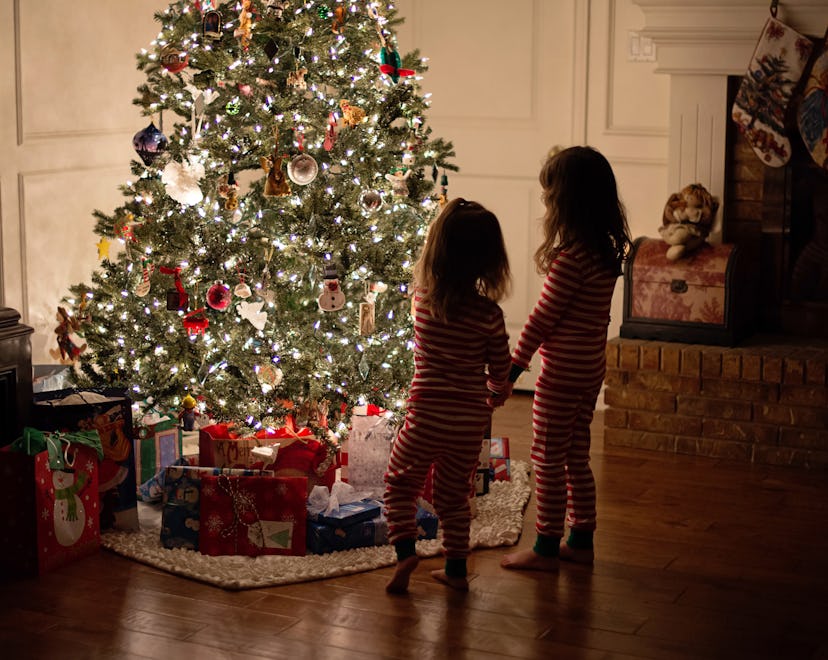Decor

Can You Leave Your Christmas Lights On Overnight? Safety Tips To Know & Follow
Enjoy the holidays, fire-free.
'Tis the season for snow, ornaments, cookies, and holiday cheer. It's also the season to decorate a beautiful tree and spend many nights gathered around it, gazing at the twinkling lights while drinking cocoa and reading your favorite Christmas stories. And the twinkling lights are one of my favorite parts of the season. I'm a professional when it comes to hanging lights and artfully weaving strands between the branches of a tree or on a house. But one thing I've never been clear on is can I leave my Christmas lights on overnight? What about my Christmas tree lights? Gone are the days of actual candles on Christmas trees, and incandescent lights seem to be phasing out, so how safe are Christmas lights these days?
Christmas light safety: Before you decorate
Before you even begin decorating your home with lights — whether they’re exterior lights, or the lights on the tree — there are some safety precautions you'll want to keep in mind while you're getting ready to hang your Christmas lights. Regardless of whether you’re planning to display the lights inside or out, the Consumer Product Safety Commission (CPSC) recommends that everyone tests all strands of Christmas lights before hanging them and check each strand of lights for frayed wires, broken bulbs, or loose connections before plugging them in. Whether your strands are old or new, by making sure that your lights are safe before you plug them in you can avoid a lot of possible dangers.
Tips for exterior lights & Christmas tree lights
Beyond just checking each strand for any faults, frays or other fire hazards, the safety rules are a little different for indoor lights and outdoor lights. For example, electric lights are a no-go if you're putting up a metallic tree this year, as faulty lights can charge your tree and electrocute anyone who touches it. Not exactly the kind of holiday excitement you're looking for. Other tips from the National Fire Protection Association (NFPA) for enjoying your Christmas lights safely and preventing holiday decor-related fires include:
- Only using Christmas strand lights as directed. If they’re marked specifically for indoor or outdoor use, for example, only use them as intended.
- Replace string lights that have any signs of damage, like loose bulb connections or worn, broken cords.
- Make sure your smoke detectors are in good working order.
- Never attach Christmas lights with nails, which could damage the cord.
- Consider switching to LED Christmas lights. Not only do they not get nearly as hot as they’ll save you a lot of money on your electric bill, too.
And when it specifically comes to outdoor Christmas decorations that you plug in (lights, inflatables, and more), you should never leave those on overnight either.
Is it safe to leave a Christmas tree on overnight?
In short, no. You should never leave your Christmas tree on overnight, or when you’re not at home. The National Fire Protection Association has a bounty of information and statistics about holiday decorations and fire hazards, because, well, Christmas tree-related fires are so relatively common and so preventible. Just how common? Between 2015 and 2019, U.S. fire departments reported an annual average of 160 Christmas tree-related fires, which “caused an average of two deaths, 12 injuries, and $10 million in direct property damage annually.”
The television show MythBusters decided to take the question of whether or not leaving Christmas lights on your tree overnight can start a fire, and put it to the test. Jamie Hyneman and Adam Savage, the hosts of the show tested whether or not leaving your Christmas lights on overnight can truly be hazardous (and cause a fire), by loading up a freshly-cut tree with a reasonable five strands of Christmas lights. They left it overnight, and came back to find a tree that was perfectly fine. But what about a tree that's not exactly fresh?
Next, the pair loaded an extremely dry tree up with five times the amount of lights they'd attempted the first time around. After just 40 minutes, the tree had heated up to 225 degrees. Though it wasn't enough to start a fire (and I doubt anyone's putting 25 strands of Christmas lights on their tree), it did show that Christmas lights alone likely aren't enough to light your tree on fire. In order for your Christmas tree lights to be a hazard, there has to be another factor, such as too many strands, outlets, or wiring, that's causing the trouble. However, following the recommended guidelines of Christmas light safety is still a good idea. From being careful not to overload your outlets, to making sure your lighting cords aren't pinched or compromised, the Electrical Safety Foundation International has important guidelines for indoor holiday lighting projects that you should adhere to for the safest possible Christmas light experience.
Though there's a good chance you turn your lights off before bed, if you're like me, you may forget every once in a while. Consider investing in a Christmas light timer to make sure your lights are getting turned off at a reasonable hour every night. Not to mention putting your lights on a timer can make your electric bill much more manageable this holiday season, which is reason enough to be filled with Christmas cheer.
This article was originally published on